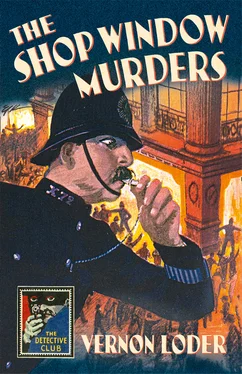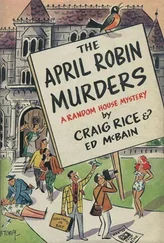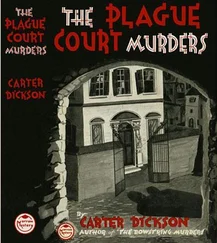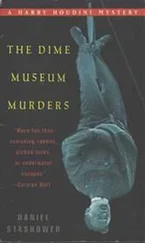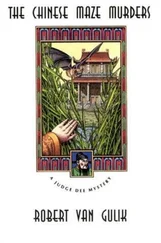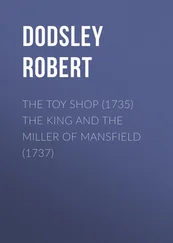The figure in blue overalls to which he referred at once drew every eye. It was not elegant or elegantly disposed, as were the others in that window. And there was something else about it that provoked a sudden shriek, and a flop, from someone in the crowd.
Most of the spectators now concentrated on giving the fainting one as little air as possible. The few who remained at the window gasped and stared, or shivered. For there is a difference between even the best wax model and the appearance of a dead man beside it.
While they shuddered and debated, the bricklayer darted across the road to a policeman and spoke to him energetically. Then, with the policeman at his heels, he hurried in through the principal door of the great stores. Someone in the meantime had removed the public nuisance, who had fainted, and the rest of the crowd surged back to see the horror.
By the time a few more people had fainted and been duly removed, those next the window saw a door panel open at the back, and the blue-coated policeman pass through it. He was followed into the ‘ballroom’ by an alarmed shopwalker, and, when they had passed through, the supererogatory figure of the bricklayer was framed in the doorway.
There was a hush outside as the constable advanced to the figure in blue overalls, reached out a long arm, and gripped its shoulder. There was a scream as the figure overbalanced and fell down, while the mask came off, and where it had been there was disclosed a face that was quite white, but had no other visible relation to wax, and bore a striking likeness to that of Mr Tobias Mander.
Then the shopwalker turned and bellowed something, and, like the safety curtain at a fire in a theatre, the blinds came down with a rush, and blotted out every trace of the tragedy from the public view.
The constable was one of those very superior policemen who have joined up since the war. He recognised Mr Mander, and he recognised the nature of the wound which had put an end to that consummate commercial impresario. He unbuttoned part of the blue overalls.
‘Gunshot wound,’ he said slowly. ‘Let’s have some more of those electrics on, and get to the telephone, and ring up our people quick as you can—Mr Mander, isn’t it?’
‘It is,’ said the horror stricken shopwalker, who looked as if he were going to be sick. ‘It’s murder, that’s what it is!’
‘Maybe,’ said the constable. ‘Now get your manager, and send for our people. They’ll bring a surgeon with them.’
The shopwalker rushed for the door at the back, ejected the bricklayer from it, and closed the panel behind him. The constable, left alone in that scene of empty and now tragic grandeur, let his eyes wander round the ballroom, and suddenly brought them to rest on something that lay on the floor beside one couple of static dancers. He looked at that first searchingly, and then at a figure of a young woman, who sat huddled back in an empire chair, just concealed from the general front view by the dancers at rest already mentioned.
The young woman’s figure wore a balloonish skirt, covered with what looked like painted diagrams of the ‘Mander Hopper’. She wore over that a loose circular cloak which had something about it suggestive of a red parachute. On her head was fixed what looked like an aeroplane propeller with red silk trimmings, and over her face a black crepe mask, while her right hand wore a kid glove.
Taking the utmost precaution to disturb as little as possible, the constable walked over to the first object, and bent down to look at it. It was a Mauser automatic pistol. From it he approached the figure of the young woman. He looked at it hard. Then he extended his index finger, and gravely pressed it against the figure’s shoulder. With that he started, bit his lip, and seemed uncertain what to do. Finally he went back to stand by the sliding panel which formed the door to the ‘set’, and waited there for someone to come.
The manager of the store, Mr Robert Kephim, a smart man of middle-age with a very stolid cast of countenance, suddenly entered. He looked at the constable.
‘Mr Hay tells me there is something suspicious here, constable,’ he said. ‘I—’
And then he stopped, and looked very uncomfortable and unhappy. He was not the type of man to feel sick or faint, but the sight of his employer lying on his back there gave him a dreadful jolt.
‘Do you recognise him, sir?’ asked the constable.
Mr Kephim swore, then he nodded. ‘Why, what has happened? That is Mr Mander—I can’t understand it.’
The constable thought that a mild remark. ‘I think the gentleman has been shot,’ he said, ‘and I shouldn’t be surprised if there isn’t another one gone west too.’
Now Mr Kephim did really go pale, and made incoherent noises in his throat.
‘That young woman in the chair over there looks too natural to be true,’ went on the constable, ‘and there is a pistol on the floor. But we must wait till they send the inspector round before we have a look at that.’
Mr Kephim switched his eyes unwillingly to the woman in the chair. His eyes went from her head to her feet, and there remained, while they appeared to grow rounder and more glaring, and his body trembled to such a degree that the constable gripped him in a friendly way to lend him support.
‘Now then, sir, steady!’ he said.
‘The shoes—her shoes, said Kephim thickly. ‘But it can’t be—it can’t!’
A curious look came into the constable’s face. He stared at the man beside him, and put a sharp question.
‘Whose shoes, sir?’
Kephim gulped. ‘It must be a mistake. Of course it is. They aren’t really uncommon—they must sell hundreds of them.’
‘Very good, sir, but perhaps you would like to tell me to whom you are referring?’
Kephim shook his head. ‘Not just now. I may later. But I don’t think it will be necessary. How soon do you think your people can be here?’
‘As they are just round the corner, they may be here any minute,’ said the constable, and went over to look at the shoes in question.
They were not evening shoes, but walking-shoes of brown leather, with a strap decorated with a serpent whose eyes were the buttons. He was still looking when the panel slid back.
Inspector Devenish, who had just come in, accompanied by a detective-sergeant and the police-surgeon, was tall and thin. He had dark hair, dark eyes, and a swarthy complexion, and might have passed as a southern Italian. Leaving the sergeant to close the panel behind them, he approached the constable, after a dry glance at the white-faced and trembling Mr Kephim.
‘What’s up here?’ he asked the constable, who saluted.
‘Looks like murder and suicide, sir,’ said the policeman.
He pointed out the body of Mr Mander, and then indicated the sitting figure of the young woman. Inspector Devenish bent over the body of the dead man, examined it cursorily, and then left it to the surgeon.
‘Now let’s see the other,’ he remarked to the constable, quite well aware that Mr Kephim had not concerned himself at all with Mr Tobias on the floor, but had continued to stare at the figure in the chair.
Devenish went over, and gently drew off the circular cloak and the mask from the huddled figure of the young woman. Then a thud behind him made him turn quickly. Mr Kephim had fainted, and fallen.
CHAPTER II Contents Cover Title Page Copyright Introduction Chapter I Chapter II Chapter III Chapter IV Chapter V Chapter VI Chapter VII Chapter VIII Chapter IX Chapter X Chapter XI Chapter XII Chapter XIII Chapter XIV Chapter XV Chapter XVI Chapter XVII Chapter XVIII Chapter XIX Chapter XX Chapter XXI Chapter XXII Chapter XXIII Chapter XXIV Chapter XXV Chapter XXVI Chapter XXVII Keep Reading … Конец ознакомительного фрагмента. Текст предоставлен ООО «ЛитРес». Прочитайте эту книгу целиком, купив полную легальную версию на ЛитРес. Безопасно оплатить книгу можно банковской картой Visa, MasterCard, Maestro, со счета мобильного телефона, с платежного терминала, в салоне МТС или Связной, через PayPal, WebMoney, Яндекс.Деньги, QIWI Кошелек, бонусными картами или другим удобным Вам способом. The Detective Story Club About the Publisher
Читать дальше
